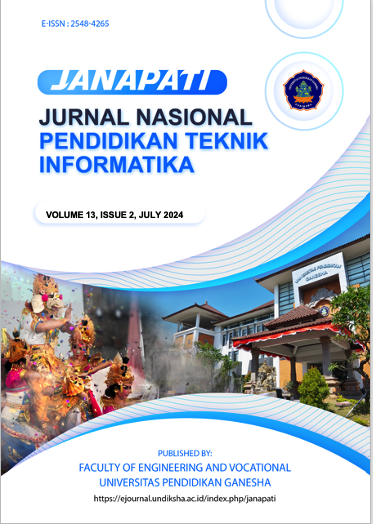An Improved Utility-Based Artificial Intelligence to Capture NPC Behaviour in Fighting Games Using Genetic Algorithm
DOI:
https://doi.org/10.23887/janapati.v13i2.82040Abstract
In computer fighting games , the ability of players to play with Non-Player Characters (NPC) is essential. A poorly designed NPC causes poor player engagement due to predictable behaviour, thus leads to unsatisfactory playing experience. We propose utility-based AI selected by genetic algorithm to determine the utility functions of each NPC action. We applied ELO ratings (usually used in chess game) to determine fitness function. Utility-based artificial intelligence can deliver human-like NPC with varied decision-making and can employ many forms of function to calculate the AI utility value. Tests on chromosomes in each generation were also carried out to obtain different responses. The Pearson Correlation coefficient is used to obtain an analysis of the influence of each assessment variable. The simulation results verify the validity of our analysis and show that our scheme influences the satisfaction level of game users
References
Christyowidiasmoro, R. C. A. Putra, and S. M. Susiki, “Measuring level of difficulty in game using challenging rate (CR) on 2D Real time Strategy Line Defense game”, Proc. - 2015 Int. Electron. Symp. Emerg. Technol. Electron. Information, IES 2015, pp. 218–222, 2016, doi: 10.1109/ELECSYM.2015.7380844.
R. Dreżewski and J. Solawa, “The application of selected modern artificial intelligence techniques in an exemplary strategy game,” Comput. Sci., vol. 192, pp. 1914–1923, 2021
K. Dill, “A Game AI Approach to Autonomous Control of Virtual Characters”, in Interservice/Industry Training, Simulation, and Education Conference (I/ITSEC) 2011, 2011, no. 11136, pp. 1–11.
Y. Hossain and L. Zaman, “NCCollab : collaborative behaviour tree authoring in game development”, in Multimedia Tools and Applications, 2022.
J. Norstad, “An Introduction to Utility Theory”, Game AI, pp. 67–80, 2005, doi: 10.1201/9780429055058-6.
N. C. Hou, N. S. Hong, C. K. On and J. Teo, "Infinite Mario Bross AI using Genetic Algorithm," 2011 IEEE Conference on Sustainable Utilization and Development in Engineering and Technology (STUDENT), Semenyih, Malaysia, 2011, pp. 85-89, doi: 10.1109/STUDENT.2011.6089330.
A. K. Adisusilo, M. Hariadi, A. Zaini, S. M. Susiki, “Optimizing of Boxing Agent Behaviour Using Genetic Algorithm,” Jurnal Ilmiah Kursor Vol 7,no. 2, pp. 55–6,2013
E. Soares de Lima, B. Feijó and A. L. Furtado, "Procedural Generation of Quests for Games Using Genetic Algorithms and Automated Planning," 2019 18th Brazilian Symposium on Computer Games and Digital Entertainment (SBGames), Rio de Janeiro, Brazil, 2019, pp. 144-153, doi: 10.1109/SBGames.2019.00028.
P. Charoenkwan, S. W. Fang, and S. K. Wong, “A study on genetic algorithm and neural network for implementing mini-games”, Proceedings - International Conference on Technologies and Applications of Artificial Intelligence, TAAI 2010, 2010, pp. 158–165. doi: 10.1109/TAAI.2010.35.
C. S. Lin and C. K. Ting, “Emergent tactical formation using genetic algorithm in real-time strategy games”, Proceedings - 2011 Conference on Technologies and Applications of Artificial Intelligence, TAAI 2011, 2011. doi: 10.1109/TAAI.2011.63. | IEEE Conference Publication | IEEE Xplore
N. R. Widiyanto, S. M. S. Nugroho, and M. H. Purnomo, “The Calculation of Player ’ s and Non-Player Character ’ s Gameplay Attribute Growth in Role-Playing Game with K-NN and Naive Bayes”, 2020 International Conference on Computer Engineering, Network and Intelligent Multimedia, 2021, Cenim 2020, pp. 103–110
Y. Jiang, B. Xiao, B. Yang, and X. Guo,”Study of plant animation synthesis by unity3D”, IFIP Adv. Inf. Commun. Technol., vol. 452, pp. 344–350, 2015, doi: 10.1007/978-3-319-19620-6_39.
J. Wang and W. Zhu, “Design and Implementation of Virtual Animation Based on Unity3D”, 2nd International Seminar on Artificial Intelligence, Networking and Information Technology (AINIT), 2021, pp. 667–669,doi: 10.1109/ainit54228.2021.00134.
H. Jeon, E. Chae, and H. Pak, “Study of Camera Path and Motion Data Creation for UNITY 3D Game Engine”, vol. 65, pp. 13–16, 2014, doi: 10.14257/astl.2014.65.04.
K. Dill, E. R. Pursel, P. Garrity, and G. Fragomeni, “Design Patterns for the Configuration of Utility-Based AI”, Interservice/Industry Training, Simulation, and Education Conference (I/ITSEC) 2012, 2012, no. 12146, pp. 1–12
S. N. Sivanandam and S. N. Deepa, “Introduction to Genetic Algorithms”, Springer Science & Business Media, 2007.
P. Bonanno and P. A. M. Kommers, ”Gender differences and styles in the use of digital games” , vol. 25, no. 1, 2005.
R. Festl, M. Scharkow, and T. Quandt, "Problematic computer game use among adolescents, younger and older adults," Addiction, vol. 108, no. 3, pp. 592–599, 2013, doi: 10.1111/add.12016.
W. Frencken, K. Lemmink, N. Delleman, and C. Visscher, "Oscillations of centroid position and surface area of soccer teams in small-sided games”, Eur. J. Sport Sci., vol. 11, no. 4, pp. 215–223, 2011, doi: 10.1080/17461391.2010.499967.
B. K. Khotimah, M. Miswanto, and H. Suprajitno, “Optimisation of feature selection using genetic algorithm in naïve Bayes classification for incomplete data”, Int. J. Intell. Eng. Syst., vol. 13, no. 1, pp. 334–343, 2020, doi: 10.22266/ijies2020.0229.31.
Downloads
Published
How to Cite
Issue
Section
License
Copyright (c) 2024 Supeno Nugroho, Lazuardi Yaqub Affan, Mauridhi Hery Purnomo

This work is licensed under a Creative Commons Attribution-ShareAlike 4.0 International License.
Authors who publish with Janapati agree to the following terms:- Authors retain copyright and grant the journal the right of first publication with the work simultaneously licensed under a Creative Commons Attribution License (CC BY-SA 4.0) that allows others to share the work with an acknowledgment of the work's authorship and initial publication in this journal
- Authors are able to enter into separate, additional contractual arrangements for the non-exclusive distribution of the journal's published version of the work (e.g., post it to an institutional repository or publish it in a book), with an acknowledgment of its initial publication in this journal.
- Authors are permitted and encouraged to post their work online (e.g., in institutional repositories or on their website) prior to and during the submission process, as it can lead to productive exchanges, as well as earlier and greater citation of published work. (See The Effect of Open Access)







